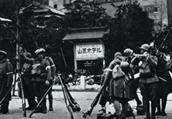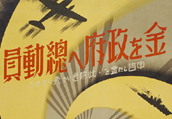HOME > Crisis in Constitutional Politics : Outline
Outline
- a. End of Party Cabinets
- b. Rise of the Military
- c. Dissolution of Political Parties and Emergence of Yokusan (Imperial Rule Assistance) System
- d. Wartime Japan
The party cabinets swiftly lost their support because of the failure of their diplomatic and economic policies, as well as intensified party strife. After the outbreak of the Manchurian Incident in 1931 (Showa 6), the Cabinet found itself unable to check the independent actions of the military. Prime Minister INUKAI was assassinated in the 15 May Incident of 1932 (Showa 7), marking the end of the prewar era of party cabinets.
In an attempt to rebuild support, the political parties engaged in various reforms of the Diet. These efforts were undercut when criticisums were leveled at the "Emperor as an Organ of Government Theory", which had given a constitutional grounding for party cabinets. This made the revival of party based politics even less likely.
Historical materials and Description
 4-1Manchurian Incident of 1931
4-1Manchurian Incident of 1931
- Army Disarmament and Prince SAIONJI [1] 11th (iii) to (vi), from HARADA Kumao's Diary
 4-25.15 Incident of 1932
4-25.15 Incident of 1932
- Memorandum of SAIONJI Kinmochi
 4-3Movements to Reform the Diet
4-3Movements to Reform the Diet
- Diet Revitalization and Discipline Blueprint
 4-4Dispute over "Emperor as an Organ of Government Theory"
4-4Dispute over "Emperor as an Organ of Government Theory"
- Biboroku ("Diary"), Vol. 7

2.26 Incident on 1936. The Sanno Hotel at Akasaka occupied by insurgent troops. From "Zusetsu Kokumin no Rekishi. Kindai Nihon no 100nen Vol.17"
In contrast to the spiraling decline of Japan's political parties during the 1930s, the military increased its influence in the Government. The military's resurgence especially was symbolized by the 2.26 Incident of 1936 (Showa 11), and the restoration of the system of allowing only active military officers to serve as Army and Navy Ministers. The latter development was used as a means to guarantee a political voice for the military, allowing it to prevent the formation of the UGAKI Kazushige Cabinet, as it did not conform to the military's wishes. When the Sino-Japanese War broke out in 1937 (Showa 12), the Japanese Government found itself unable to control the military, and haplessly bogged down.
Historical materials and Description
 4-5Army Factional Infighting
4-5Army Factional Infighting
- Memorandum on the Army Purge, MURANAKA Koji and ISOBE Asaichi
 4-6Clean Election Movement
4-6Clean Election Movement
- Clean Election Women's Federation's Agreement Patriotic Women's Association, Appealing to the 40 Million Women of Japan for Clean Elections
 4-7The 2.26 Incident of 1936
4-7The 2.26 Incident of 1936
- Army Minister Bulletin
 4-8Stillbirth of the UGAKI Cabinet
4-8Stillbirth of the UGAKI Cabinet
- Memorial Declining the Imperial Order to Form a Cabinet (Manuscript)
- "Extra!", Hochi Shinbun
The opportunity presented it see for Japan to form an alliance with Germany following the initial successes of that country after the outbreak of the Second World War in Europian in 1939 (Showa 14). Domestically, the movement led by KONOE Fumimaro to create a new political system grew in strength, and in 1940 (Showa 15), all political parties dissolved themselves and replaced by the Taisei Yokusankai (Imperial Rule Assistance Association). While some members of the Diet were critical of to the Yokusan (Imperial Assistance) system, the Diet till the war's end turned into an organization that cooperated in the pursuit of the war.
Historical materials and Description
 4-9Transformation of the Proletarian Political Parties
4-9Transformation of the Proletarian Political Parties
- Declaration, 6th Convention of the Shakai Taishuto
 4-10Anti-military Speech
4-10Anti-military Speech
- Representative SAITO's Statements Ignoring Admonition
- Kampo (Official Gazette) Gogai (Extra) , Stenographic Record of Legislative Proceedings of the 75th Session of the Imperial Diet House of Representatives number Five, Number Six
- Excised Portion of SAITO Takao's Speech
 4-11Prince KONOE's New Party
4-11Prince KONOE's New Party
- Diary of ARIMA Yoriyasu
- Notification of Disbandment of Political Parties
 4-12Taisei Yokusankai (Imperial Rule Assistance Association)
4-12Taisei Yokusankai (Imperial Rule Assistance Association)
- Basic Plan for Realizing the Taisei Yokusankai
 4-13Outbreak of War Between Japan and the U.S.
4-13Outbreak of War Between Japan and the U.S.
- Letter from KONOE Fumimaro to ARITA Hachiro
- Letter from YOSHIDA Shigeru to MAKINO Nobuaki
 4-14Imperial Rule Assistance Political Association
4-14Imperial Rule Assistance Political Association
- Proceedings of the General Convention Establishing the Imperial Rule Assistance Political Association: General Outline of Bylaws of Imperial Rule Assistance Political Association Proclamation; the Platform
 4-15The Yokusan (Imperial Rule Assistance) System
4-15The Yokusan (Imperial Rule Assistance) System
- Overview of Great Japan Women's Association
 4-16KOISO Cabinet (Restoration of the Parliamentary Ministers System)
4-16KOISO Cabinet (Restoration of the Parliamentary Ministers System)
- Daily Logs of September-October 1944 (Showa 19)
 4-17Efforts to End the War
4-17Efforts to End the War
- Diary of TAKAGI Sokichi

Money (gold) mobilized by the government (Poster Collection contributed by Okada Akio, #4-6)
National Mobilization Law was passed in 1938 (Showa 13) to deal with total war. The people were also enlisted to cooperate in the wartime framework, being organized through such systems as the Taisei Yokusankai and the Dai-Nippon Sangyo Hokokukai.
Meanwhile, the prolonged war caused an intense shortage of goods and materials in Japan, subjecting people's livelihoods to great hardships. As the end of the war approached, the main islands of Japan were also bombed heavily, causing tremendous damage.
Historical materials and Description
 4-18Life on the Home Front
4-18Life on the Home Front
- Air Defense Manual
- Folding Fan
 4-19Total National Mobilization
4-19Total National Mobilization
- National Mobilization Plan for 1942 (Showa 17)
- Revised Outline of Resource Mobilization Plan for 1944 (Showa 19) (Appended to Supply Capacity Blueprint)
 4-20National Diet Building Struck by American Bombs
4-20National Diet Building Struck by American Bombs
- OKI's Account of the War Devastation of 16 May - 8 June and 14 July 1945 (Showa 20)
- Tactical Mission Report Mission No.183
- Mission Summary Mission Number 183
 4-21Deterioration of War Situation
4-21Deterioration of War Situation
- Pamphlets Dropped by U.S. Military on Japan
- Hiroshima Reconstruction: Urban Planning Map for Street Network and Park Layout (1:20,000 scale)
- Nagasaki City Map (1:10,000 scale)